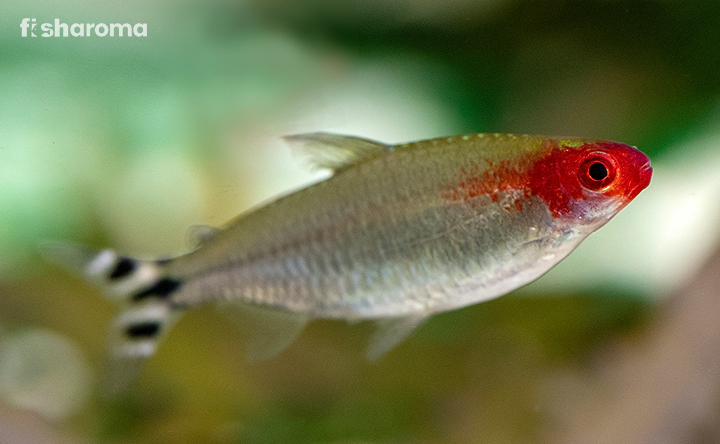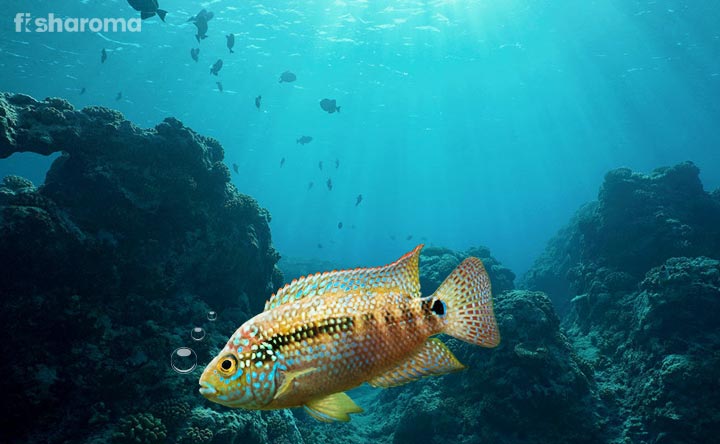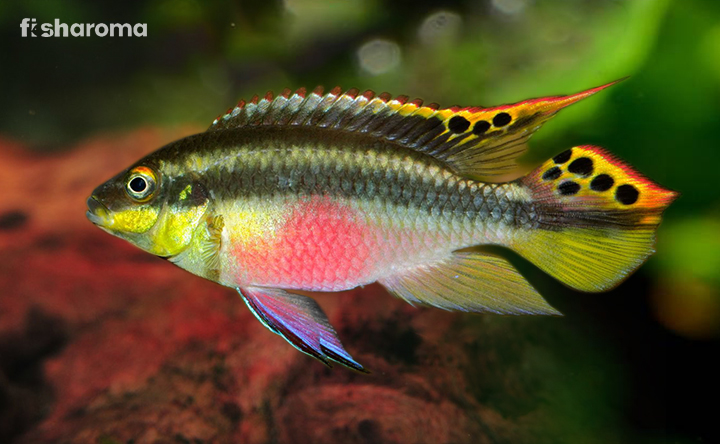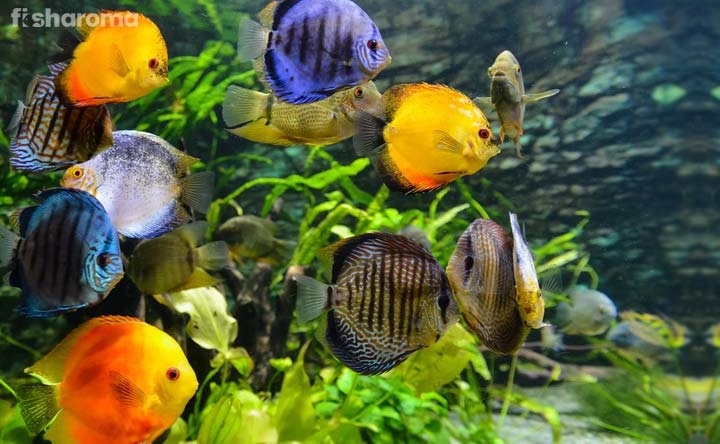Rummy Nose Tetra – Care Guide To Tiny Swimmers

- Origin And Habitat Of Rummy Nose Tetra
- Appearance Of Rummy Nose Tetra
- Behaviour Of Rummy Nose Tetra
- Lifespan Of Rummy Nose Tetra
- Diet Of Rummy Nose Tetra
- Tank Requirements Of Rummy Nose Tetra
- Water Type For Rummy Nose Tetra
- Compatibility Of Rummy Nose Tetra
- Breeding Of Rummy Nose Tetra
- Diseases And Treatments Of Rummy Nose Tetra
- Summary
Rummy Nose Tetra is a common name given to three similar fish species. They are The Common Rummy Nose Tetra (Hemigrammus bleheri ), The True Rummy Nose Tetra (Hemigrammus rhodostomus), and the False Rummy Nose Tetra (Petitella georgiae). These fishes belong to the Tetra fish group, as suggested from their name and they are all small to medium in size. Their temperament is peaceful and they are tank-friendly fishes.
These species have unique resemblance in terms of their appearance and it is difficult to distinguish one species from another. So, we will provide an overall care guide to these all.
Key Specifications Of Rummy Nose Tetra
Quickly go through the table to get an instant idea regarding these beautiful Rummy Nose Tetras.
| Origin | South America |
| Lifespan | 5-6 years |
| Colours | Grey, red, black, and white |
| Temperament | Docile |
| Size | 1.75-2.5 inches |
| Diet | Omnivorous |
| Reproduction | Egg-laying |
| Maintenance Requirements | Easy |
| Tank Size | Around 20 gallons |
Overview
Rummy Nose Tetras are from freshwater and tropical water bodies. Their shoaling behaviour makes them perfect for a community fish tank. Additionally, their tiny but colourful body looks great when looked from the sides. They are one of the most sought after pet choices because of their less demanding attitude and passive nature. From their diet to their breeding, everything is as uncomplicated as they can be.
Origin And Habitat Of Rummy Nose Tetra
Rummy Nose Tetras are from the Amazon River Basin. Their distribution is in countries like Brazil, Venezuela, Peru, and Colombia. The rivers where these fishes are mostly found are Orinoco River, Rio Negro, Rio Meta, Rio Madeira, Rio Negro, and Rio Purus.
The fishes swim in the shallow water, lacking in minerals but enriched with tannin or decomposed organic matter. The water is dark and vague due to this reason.
Appearance Of Rummy Nose Tetra
Regardless of the species, all Rummy Nose Tetras have a torpedo-shaped body and a slender appearance. The thinness gradually transforms into slightly plumpness towards the head. Due to their silhouette, their swimming is so effortless.
Size
The small fishes size mostly between 2-2.5 inches.
Colour
The entire body is shimmery grey and the mouth is red tinted. The redness can surpass the snout and eyes, reaching even on the upper part of the gill and the body. Although that is exceptional, it happens. Some can showcase a light greenish hue on their fins, but dorsal and pectoral fins are essentially translucent. The caudal tail has a black and white combined stripe pattern. The number of the stripes are changeable in each species and they usually count between 3 to 5. You can see a black pattern on their anal fin.
Behaviour Of Rummy Nose Tetra
Rummy Nose Tetras are active swimmers, covering mostly the middle part of the tank, just like they do in the wild. Their energetic attitude keeps the tank vibrant all the time. They are good to be placed with other community or schooling species. In fact, they will be upset and might lose their glamour if they find themselves alone in the tank. Rummy Nose Tetras are also great explorers, but they do it unitedly and not alone. You can find some of them close to the substrate when they are looking for food, that deed is also done together.
These gentle fishes never harm any other tank mates, rather appreciate others’ presence.
Lifespan Of Rummy Nose Tetra
The average lifespan of the fish is 5-6 years, which is pretty good. Although, in captive breeding you tend to get fishes that have longer lifespans than its other cousins. A few breeders have witnessed individual fishes, living nearly 8 long years.
However, it all comes down to your care level and ultimately how well you are handling the species will be reflected through its physical features. To raise a happy and healthy fish includes proper feeding and emulating its natural domain inside the tank.
Diet Of Rummy Nose Tetra
Feeding this omnivorous fish is not a problem because they readily consume both live food as well as plant debris and algae. In the wild, they survive on insects, eggs, and plants equally. Imitate that while you are feeding the Tetra in your tank.
While commercially available flake or pellets are good for them, ensuring their nutrition value. You should give them some live or frozen foods as treats or snacks a couple of times every week. You may also include vegetables as their treats.
Keep in mind, that mouth is extremely tiny, so the foods you are giving should be small in quantity, so that they can be consumed without any problem. Also, untouched, halfeaten, leftover food might pollute the water condition. So, provide as much as your Tetra can consume. Now, after observing your fish you will get an idea as, how fast they can chew and complete their meal. Accordingly, take a small portion of food that they can finish within 2 minutes and that should be your standard feeding quantity.
There are some differences of opinions regarding the feeding time. We suggest keeping it twice per day, because overeating is bad for the fishes. Many aquarists feed them multiple times a day, but that depends on individual fish and their needs. You have to keep close watch to their eating pattern.
These are the names of the foods that you will give your Rummy Nose Tetra
- Daphnia
- Brine Shrimp
- Bloodworm
- Flake food
Tank Requirements Of Rummy Nose Tetra
Rummy Nose Tetras are shoaling species, meaning they stay together and explore their surroundings unitedly. Interestingly, that doesn’t mean they need big tanks. Their wellbeing depends a lot on the type and standard of the water, which needs to be warm.
Tank Size
A group of 9-10 Rummy Nose Tetras can happily stay and thrive in a 20 gallon tank. They are not demanding about their space, but the more, the better. Don’t compromise this aspect because the environment that a fish is brought up in, has a tremendous impact on its health. You can always add new fishes, but make sure to add 2 gallons of water per fish. Also, if you keep them inside a community fish tank with other groups of fishes, then you will need a much bigger tank for sure.
Tank Lid
A tank lid is supposed to make sure that the tank is free from any dirt and dust. Also, some of the Rummy Nose Tetras can jump out of the tank, it could be either by stress or they could be a victim of any aggressive neighbour in the aquarium. The lid will protect the fishes from all these aspects.
Substrate
The bottom should have a sandy surface, preferably a dark one, so that the colour of the fishes are exhibited properly. Also, these fishes are not bottom-dwellers, rather they rarely make any appearance at the substrate, so instead of sand, gravels also work good. Although our suggestion is always sand, because even if they do come to explore the bottom, the softness of the sand will not harm or injure their snout.
Filter
Install a powerful external filter that will purify the water and keep the fish safe from pollutants. It will keep the ammonia and nitrate of the water in check, and that is a big relief, because your Rummy Nose Tetra is sensitive to those things. Remember, while an undergravel filter cleans out the bottom water, the peat filtration is required for keeping the water soft and perfect for the Rummy Nose Tetra.
Ornaments
There is nothing off the chart for the pretty fishes because they enjoy everything and not make a fuss about it. Since they occupy mostly the middle part of the tank, you must keep that zone empty or less cluttered with your fish tank decoration. Otherwise, driftwoods, artificial or synthetic ships, bogwood, rocks all can be put together inside the tank. The fishes can use them as their hiding places and can spend some time alone. The driftwoods help release the tannins, that is how the water of the tank stays exactly the same for the Tetras, as they are in their natural domain.
Presence Of Flora
Rummy Nose Tetras don’t mind any plants around them, rather they could use the plants as their shelter. Opt for anchored as well as floating plants for the tank. Make sure that these plants are not making it difficult for the fish to swim. You can opt for plants like Anubias, Java Moss, Java Fern, and Guppy Grass. These are also great options for a breeding tank as well, because female Rummy Nose Tetra lays eggs on such plants only.
Throw some Alder Cones and Indian Almond leaves so that they can add to the naturally brownish water.
Cleaning Method
Weekly clean the tank with a towel and wipe off dust from the tank. The decorative items should be rinsed and cleaned as well. There shouldn’t be any leftovers, at any cost, inside the aquarium, polluting the water quality. Check the water quality as well, because that is a parameter you need to maintain, even while cleaning. Remove and replace the foliage on a regular basis.
Water Type For Rummy Nose Tetra
We have already informed you that these fishes thrive in warm water, which is also brackish in nature. You must keep a water heater handy at all times, to maintain the warmth of the water.
Temperature
The water should range within 22-29 Degrees Celsius. Ideally, you can keep the water parameter set at the middle of the temperature as that would be the best for the fishes.
pH Level
In the wild, the Rummy Nose Tetras survive when the water pH is 4.0, but captive-bred fishes have more endring power in terms of the acidic water. Keep the pH level within 5.5-6.8.
Water Hardness
While the general hardness of the water should be 2-8 dGH, the carbonate hardness of the water should be 2-6 KH.
Mineral
The sensitive fishes require water with nitrogenous products measuring 0 ppm. They cant tolerate ammonia in particular.
Replacement Procedure Of Water
You need to change and replace 10% of the tank water, twice in every week. As this will ensure that the water is clean and free from all the detrimental pollutants that can possibly harm the fish. Using a water testing kit everytime you change the water and at other times will indicate the water quality.
Compatibility Of Rummy Nose Tetra
Though these fishes are welcoming enough for other fishes, you need to make a careful selection about its mate. Since Rummy Nose Tetras are uniquely coloured, they can be an easy victim of big predatory fishes. You should consider the nature of Rummy Nose Tetras and others, to know if they can coexist in the tank or not.
Suitable Tank Mates
Compatible tank mates for Rummy Nose Tetras include those who are mostly bottom dwellers. This is because, Rummies swim in the middle zone of the water and their tank mates stay at the bottom, so there is no way to clash. Although not all of their tank mates are bottom-dwellers, some of them are exactly like the Tetras, but since all of their water requirements and dietary needs are similar, they can exist together without harassing each other.
- Dwarf Gouramis
- Harlequin Rasboras
- Pearl Gouramis
- Yoyo Loaches
- Green Neon Tetras
- Cherry Barbs
- HatchetFish
- Shrimps
- Snails
- Mollies
- Zebra Danios
- Celestial Pearl Danios
- Dwarf Pencilfish
- Bumblebee Gobies
Unsuitable Tank Mates
Unsuitable are those, whose water requirements and temperaments are different from Rummy Nose Tetras. You should remember that the purpose of keeping a community tank is to showcase the beauty of multiple fishes together. If that is not maintained then there is no point in making different species stay together forcefully. The incompatible mates for your Rummy Nose Tetra are
- Goldfishes
- Crayfishes
- Leaf Fishes
- African Butterfly Fishes
- Cichlids
- Barbs
Breeding Of Rummy Nose Tetra
There is no rocket science involved in the breeding of the fish. However, you can ensure that the water is around 28 Degrees Celsius, with a carbonate hardness of 4-6 KH. The water needs to be slightly acidic like 6-6.2.
These parameters are good enough to encourage spawning, and once the mating is done, you can see the female fish laying eggs on the spawning nets or on the plants. You need to separate the parents fish immediately from the eggs. Otherwise, the fishes can eat the eggs and there will be no baby fish or “Fry” left for hatching.
The eggs will take around 1 day or 1.5 days to hatch. Initially they will be eating the egg sac and staying close to the surface. After some time they will start swimming like adults and in the meantime to ensure their nutrition, you can feed them infusoria. You can also try powdered Brine Shrimp for the same purpose as well.
Diseases And Treatments of Rummy Nose Tetra
Rummy Nose Tetras are extremely sensitive to fluctuating qualities of their water and food. You need to keep the water quality prim and proper all the time, if you need happy Tetras swimming in your tank.
Apart from these, they can be a victim of Ich, characterized by white spots all over the body. The fish might rub its body against the tank glass when affected by Ich. This parasitic disease might need a tablespoon of salt incorporation in 5 gallons of water. Still it is best to use the remedy that a professional veterinarian suggests.
Dropsy is another thing that a Rummy Nose Tetra can easily suffer from. This can happen either from a bacterial or any parasitic infection. As a result the body is swollen and it needs proper medical intervention.
Summary
Rummy Nose Tetra is a shoaling fish, with a colourful head and iridescence scales to showcase. Their diet, water needs, everything is so minimal that keeping them is never a problem for aquarists. Even beginners can care for them with great gusto, and it needs no prior experience. They are usually peaceful and their aggression is not observed ever. However, it takes a good owner to understand what his/her pet fish needs. That information, we believe, you have already got from us.
Other Similar Care Guides
Like Rummy Nose Tetras, we have many other fascinating fish articles like the following
- Sterbai Cory – The fish is a catfish, found in the saltwater of South America. This is mostly a peaceful and inactive species. You can’t expect much activity from it, but it’s nocturnal instinct maken it interesting.
- Pea Puffer – Alternatively known as Dwarf Puffer, these fishes are territorial. Despite their nature, they are a famous pet choice.
- Gold Nugget Pleco – The small pleco has beautiful colouration, studded with black and yellow. This is also a bottom-dweller fish, hardly swimming upwards.









